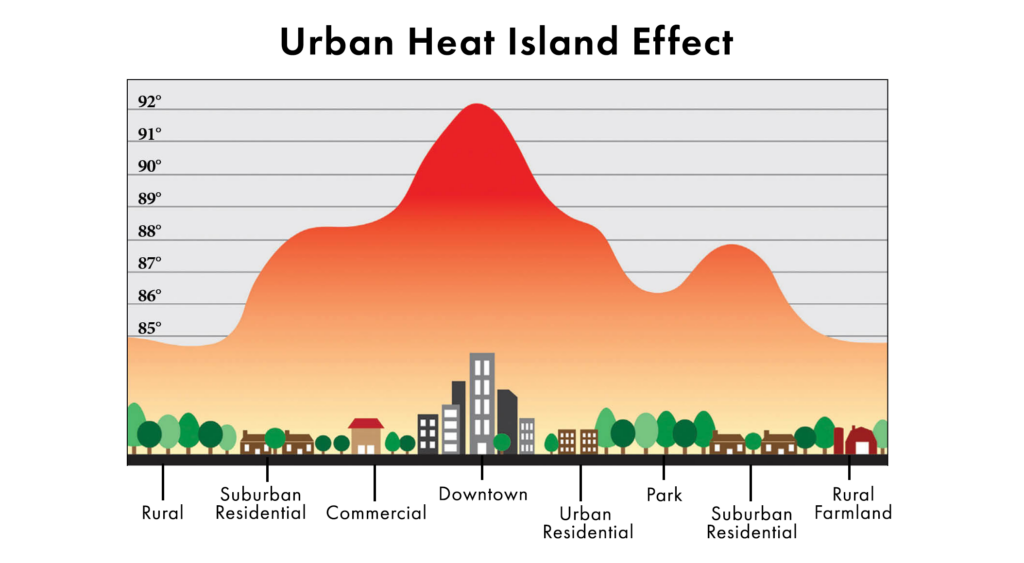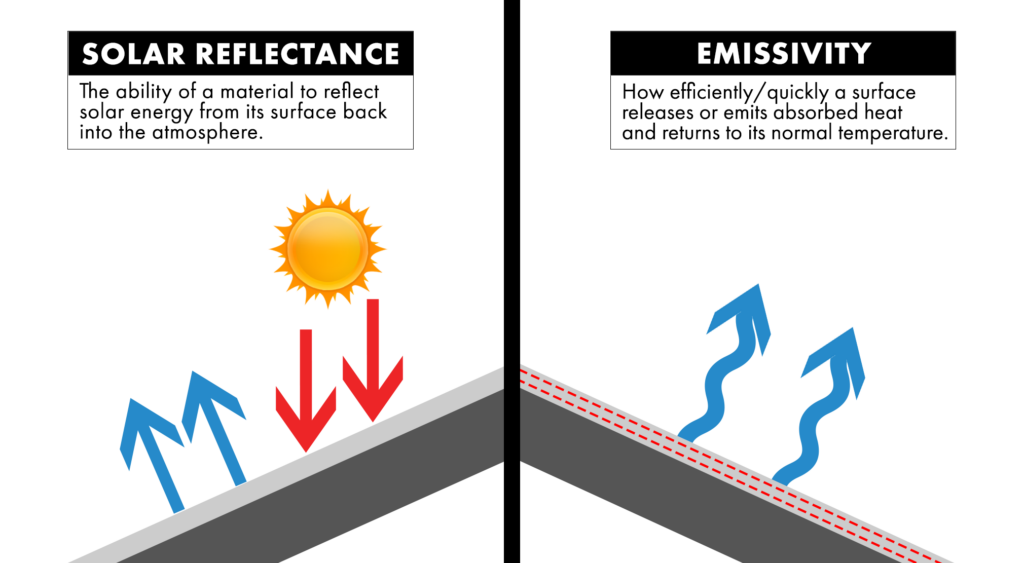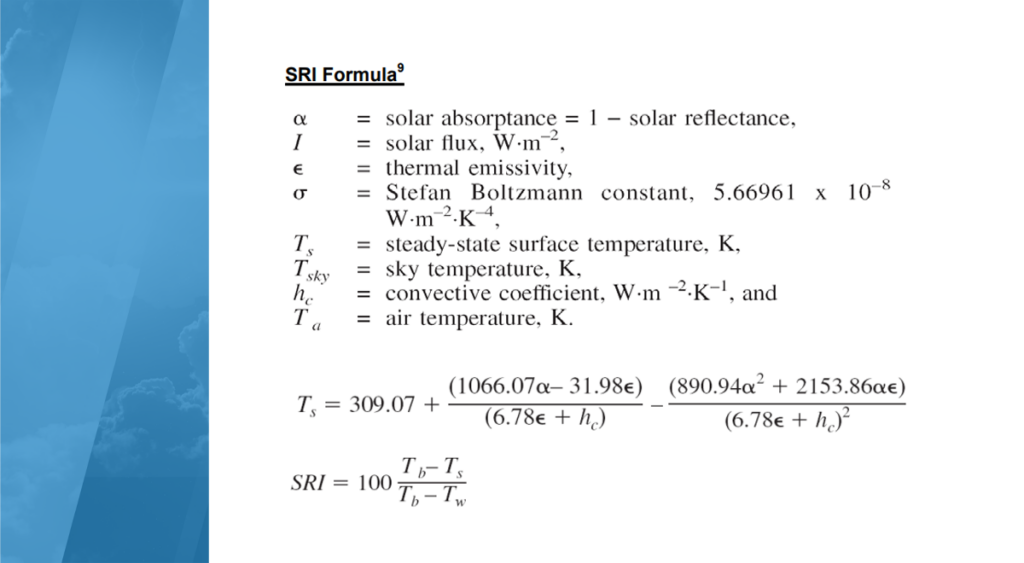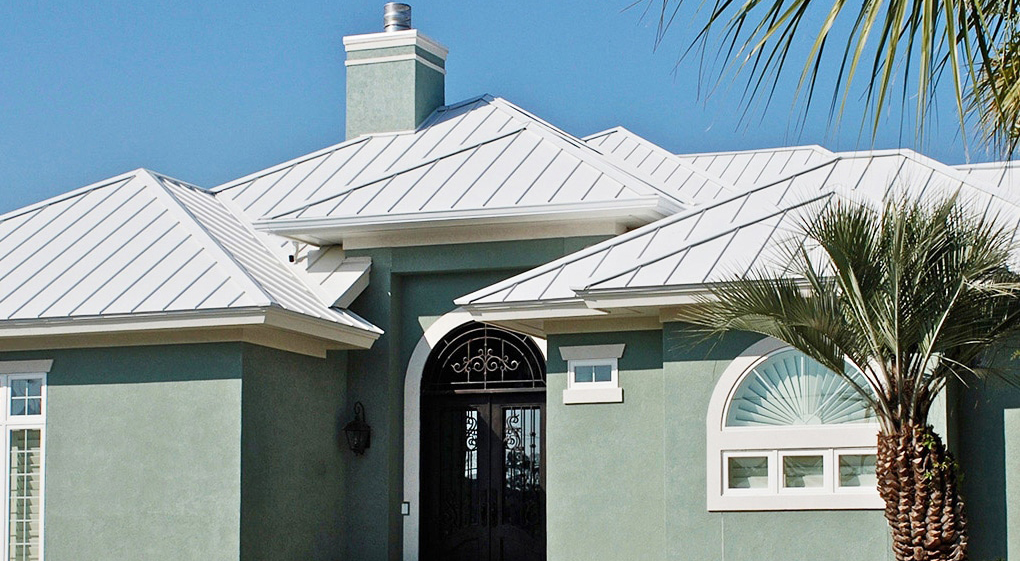*EDITOR’S NOTE: Effective on June 1, 2022, all roofing products that have received the ENERGY STAR® designation will no longer be recognized under that distinction. The ENERGY STAR label will still exist for other consumer goods, but the roofing products designation will not. Click here to read our full article about the sunsetting of the ENERGY STAR Certified Roof Program.
This article was originally posted in May 2019. Even though the ENERGY STAR roofing program is no longer recognized today, the following information is still relevant and beneficial in measuring cool metal roofing.
As the emphasis on conservation and sustainability dramatically increased over the past 15 to 20 years, so has the demand for cool metal roofing products.
You might be asking yourself several questions, such as:
- What exactly is cool metal roofing?
- What is used to measure the “coolness” of a roof or wall panel?
- How does it help reduce energy consumption?
These are all valid questions that deserve a thorough explanation.
Here at Sheffield Metals, the bulk of our metal coils and sheets consist of our energy-efficient metal roofing metal brand, COOLR®, which is a metal roof and wall product engineered to meet energy efficiency compliance standards (i.e., LEED, the Cool Roof Rating Council, ENERGY STAR*, etc.).
In other words, we know how important it is to have sustainable roofing products for architects to specify, contractors to install, and property owners to benefit from. Let’s discuss cool roofing further and dive deeper into how its heat tendencies are measured.

What Is Cool Metal Roofing? Definition & Uses
Cool metal roofing is defined as painted or coated metal products that reflect the sun’s energy to dissipate heat. Cool roofs help to reduce the heat that is transferred into the building, which can result in total cooling cost energy savings ranging from 7% to 15%, according to the Green Building Alliance.
In fact, cool metal roofing doesn’t have anything to do with the metal substrate itself – it’s solely dependent on the paint or coating system that is applied to the substrate during the manufacturing process. The cool PVDF paint/resin formula (formulated by Sherwin-Williams or another paint supplier) contains innovative solar reflective pigments, which is the key differentiator.
The Benefits of Cool Metal Roofing
Cool metal roofing has many benefits beyond savings on energy costs. It’s commonly specified because it helps to reduce the urban heat island effect, which is defined as:
“Built-up areas that are hotter than nearby rural areas. Heat islands can affect communities by increasing summertime peak energy demand, air conditioning costs, air pollution/greenhouse gas emissions, heat-related illness and mortality, and water quality.”

Many urban areas have buildings and infrastructure made of concrete, which is why cities are sometimes referred to as “concrete jungles.” The problem with concrete is that it absorbs heat and retains that warmth for more extended periods and therefore keeps its surroundings warmer than places without as much concrete.
Beyond the heat island effect, cool roofing can help reduce the electricity demand, which reduces potential power outages and blackouts. The push for building materials that reduced energy consumption, including cool roofing, was made a priority in response to the 2003 Northeast U.S. blackout.
In conjunction with lower energy consumption, cool roofing can help reduce “power plant emissions, including carbon dioxide, sulfur dioxide, nitrous oxides, and mercury, by reducing cooling energy use in buildings,” according to the U.S. Department of Energy.
Common Measurements of Cool Roofing: Solar Reflectance, Emissivity, & SRI
When designing a property with a more eco-friendly, cool metal roof or wall system, several measurement terms come up, including:
- Solar reflectance
- Emissivity (also called thermal emittance)
- Solar Reflectance Index (SRI)
In the early to mid-2000s, legislation and regulations were established to reinforce sustainability and combat increasing problematic energy consumption. That’s how the three terms listed above came into prominence, as these measurements are how cool roofing is determined.
Let’s dive deeper into the meaning of each one.
Solar Reflectance: Definition & Uses

Solar reflectance is the ability of a material to reflect solar energy from its surface back into the atmosphere. Solar reflectance is measured in decimals on a scale from 0 to 1, where 0 would be considered the truest black and 1 would be considered the truest white.
As it applies to designing a metal roof, measuring the solar reflectance is divided up into two categories: Low-slope roofing and steep-slope roofing applications.
ENERGY STAR®* Program Requirements for Roof Products:
| Initial Solar Reflectance | Solar Reflectance After 3 Years | |
| Low Slope Roofing (2:12 & Below) | Greater than or equal to 0.65 | Greater than or equal to 0.50 |
| Steep Slope Roofing (Above 2:12) | Greater than or equal to 0.25 | Greater than or equal to 0.15 |
Emissivity (Thermal Emittance): Definition & Uses
Emissivity is a measure of how efficiently and quickly a surface releases/emits absorbed heat and returns to its normal temperature. Emissivity is determined on a decimal scale from 0 to 1, where a 1 represents the most efficiently emissive material possible. In essence, the higher the number, the better it will be at cooling itself.
There are varying levels of emissivity levels cited throughout the industry as the minimum for cool metal roofing and can range anywhere from 0.70 to 0.85. At Sheffield Metals, we follow ENERGY STAR’s* emissivity requirement for both low-slope and steep-slope roofing applications, which is greater than or equal to 0.75.
Solar Reflectance Index (SRI) Definition & Uses
Solar Reflectance Index is a measure of a surface’s ability to reflect the sun’s solar energy (solar reflectance) and emit heat (emissivity). SRI is measured on a scale from 0 to 100. An SRI value closer to 0 indicates a darker or black surface and a value closer to 100 indicated a brighter or white surface.
SRI is a little more complicated to define because it’s measured using a complex formula that includes more than just the solar reflectance and emissivity values:

However, to make it easier, the Lawrence Berkeley National Laboratory created a downloadable SRI calculator where you can input the solar reflectance and emissivity values, and it will calculate it for you.
One of the more critical measures of building sustainability is referred to as LEED, the Leadership in Energy and Environmental Design. LEED is a building rating system available for nearly all building and home projects that provides the framework for businesses, contractors, and property owners to follow to be recognized as sustainable. SRI values are used in determining if a building material is LEED compliant.
Minimum SRI for Cool Roof Materials in LEED v4:
| Initial SRI Value | SRI Value After 3 Years | |
| Low Slope Roofing (2:12 & Below) | Greater than or equal to 82 | Greater than or equal to 64 |
| Steep Slope Roofing (Above 2:12) | Greater than or equal to 39 | Greater than or equal to 32 |
Cool Metal Roofing & Cost Savings
Nowadays, cool roofing is similarly (if not the same) priced to non-cool metal roofing. In addition to metal’s versatility, strength, and longevity as roof and wall systems, this little to no price discrepancy means that cool roofing is getting specified and installed more frequently in architectural projects.
As far as energy cost savings go, the best way to illustrate how a cool metal roof can benefit the property owner and, by extension, the greater good is to explain how the solar reflectance level can reduce energy costs.
According to the Lawrence Berkeley National Laboratory:
- For every 1% increment in roof reflectance, the surface temperature of the metal roof decreases 1 degree Fahrenheit.
- For every 10% increase in roof reflectance, heating/cooling costs drop 2 cents per square foot per year.
Keep in mind that these numbers will vary based on location and utility costs, but still offers a good representation of how cool metal roofing with a high solar reflectance can help a consumer save on their energy bills. For a more in-depth roof savings measurement, check out the Oak Ridge National Laboratory’s comprehensive roofing savings calculator.
Factors to Keep in Mind About Cool Metal Roofing
Metal Sheet/Coil Colors & Finishes
As long as the metal sheet and coil are categorized as cool roofing by the manufacturer, you can expect it to have energy-saving characteristics. That being said, some colors and finishes can increase and decrease the effectiveness.
- Colors: SMI’s paint colors Solar White and Medium Bronze are both cool metal coils/sheets (COOLR®), but have very different SRI values. Solar White has an SRI of 82, while Medium Bronze has an SRI of 31. In essence, Solar White will be noticeably cooler to the touch and will offer more energy savings for the end-user. However, Medium Bronze will still offer savings over non-cool roofing, but it will just be on a smaller scale.
- Finishes: The specific type of finish also factors into the SRI measurements of cool roofing as well. For example, high-gloss finishes tend to have a higher solar reflectance and SRI than low-gloss or matte finishes.
Varying Environments
Heat, cold, dry, rainy, or otherwise: Cool metal roofing is beneficial in all environments. However, some locations will experience more a significant percentage of cost savings than others. Specifically, cool roofing will be most efficient in saving on energy costs in hotter climates, as the metal panels will reflect and emit more heat in these environments.

Roofing Pitch/Slope
As we mentioned above, the roofing slope plays heavily into the compliance requirements. Low-slope roofs face the sun on a more consistent and extended period of time than steep-slope roofs because they’re flatter, which is why the reflectance and SRI values must be higher to withstand the longer duration of heat from the sun.
Final Thoughts on Cool Metal Roofing
Cool metal roofing continues to rise to prominence as a more sustainable and cost-saving building material to use on commercial, architectural, residential, agricultural, and government properties.
Best of all, cool roofing is:
- High in solar reflectance, emissivity, and SRI values
- Helpful in pushing utility cost savings to the property owner
- Useful in reducing the urban heat island effect and overall energy consumption
- Readily available, cost-effective, and easy to specify
After over 20 years of manufacturing metal sheet and coil products for metal roof and wall projects, Sheffield Metals knows the importance of providing architects, designers, and beyond with sustainable cool metal roofing options.
That’s why we almost always recommend specifying and installing systems using COOLR, a family of sustainable, energy-efficient roofing products that meet ENERGY STAR* and LEED compliance in many of our paint finishes. To discuss your specification requirements or cool metal roof/wall details, please contact our helpful Architectural Department today!
